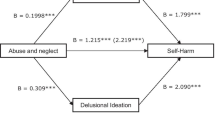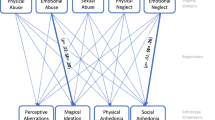Abstract
Introduction
There is an increasing body of evidence suggesting an association between early adverse events and an increased prevalence of sub-clinical psychotic phenomena. These ‘schizotypal’ beliefs and experiences have been associated with a history of trauma, and are also recognised as a risk factor for the transition to psychosis. However, previous studies have not investigated the associations between specific types of adverse event and the distinct dimensions of such phenomena.
Methods
An internet questionnaire produced three groups of participants who had suffered discrete forms of childhood abuse.
Results
Individuals who had suffered physical or sexual abuse exhibited higher levels of paranoia/suspiciousness and unusual perceptual experiences, but not magical thinking. Individuals who had suffered emotional abuse did not show higher scores within any of these three measures of schizotypy.
Conclusion
The results suggest the need for further research to improve the specificity of the identification of individuals who may be at risk of a transition to psychosis.
Similar content being viewed by others
References
Antony M, Bieling P, Cox B, Enns M, Swinson R (1998) Psychometric properties of the 42-item and 21-item versions of the depression anxiety stress scales in clinical groups and a community sample. Psychol Assess 10:176–181
Bebbington P, Bhugra D, Bhugha T, Farrel M, Lewis G, Meltzer H et al (2004) Psychosis, victimisation and childhood disadvantage: evidence from the second British National Survey of Psychiatric Morbidity. Br J Psychiatry 185:220–226
Bernstein D, Fink L, Handelsman L, Foote J, Lovejoy M, Wenzel K et al (1994) Initial reliability and validity of a new retrospective measure of child abuse and neglect. Am J Psychiatry 151:1132–1136
Birnbaum MH (2001) Introduction to behavioural research on the Internet. Prentice-Hall, Englewood Cliffs
Campbell M, Morrison AP (2007) The relationship between bullying, psychotic-like experiences and appraisal in 14–16 year olds. Behav Res Ther 45:1579–1591
Cawson P, Wattam C, Brooker S, Kelly G (2000) Child maltreatment in the United Kingdom: a study of the prevalence of child abuse and neglect. NSPCC, London
Claridge G (1997) Schizotypy: implications for illness and health. Oxford University Press, Oxford
Claridge G, Broks P (1984) Schizotypy and hemisphere function: I. Theoretical considerations and the measurement of schizotypy. Pers Individ Differ 5:633–648
Claridge GS, McCreery C, Mason O, Bentall R, Boyle G, Slade P et al (1996) The factor structure of ‘schizotypal’ traits: a large replication study. Br J Clin Psychol 35:103–115
Cukor D, McGinn L (2006) History of child abuse and severity of adult depression: the mediating role of cognitive schema. J Child Sex Abus 15:19–34
Fowler D, Freeman D, Smith B, Kuipers E, Bebbington P, Bashforth H et al (2006) The brief core schema questionnaire (BCSS): psychometric properties and associations with paranoia and grandiosity in non-clinical and psychosis samples. Psychol Med 36:749–759
Freeman D, Garety PA, Kuipers E, Fowler D, Bebbington PE (2002) A cognitive model of persecutory delusions. Br J Clin Psychol 41:331–347
Garety PA, Kuipers E, Fowler D, Freeman D, Bebbington PE (2001) A cognitive model of the positive symptoms of psychosis. Psychol Med 31:189–195
Henquet C, Krabbendam L, Spauwen J, Kaplan C, Lieb R, Wittchen H et al (2005) Prospective cohort study of cannabis use, predisposition for psychosis, and psychotic symptoms in young people. Br Med J 330:11–16
Hewitt JK, Claridge G (1989) The factor structure of schizotypy in a normal population. Pers Individ Differ 10:323–329
Janssen I, Krabbendam L, Bak M, Hanssen M, Vollebergh W, Graff R et al (2004) Childhood abuse as a risk factor for psychotic experiences. Acta Psychiatr Scand 109:38–45
Johns LC, van Os J (2001) The continuity of psychotic experiences in the general population. Clin Psychol Rev 21:1125–1141
Johnstone EC, Ebmeier KP, Miller P, Owens DG, Lawrie SM (2005) Predicting schizophrenia: findings from the Edinburgh high-risk study. Br J Psychiatry 186:18–25
Kubany ES, Leisen M, Kaplan A, Watson S, Haynes S, Owens JA et al (2000) Development and preliminary validation of a brief broad-spectrum measure of trauma exposure: the traumatic life events questionnaire. Psychol Assess 12:210–224
Laroi F, Van der Linden M, Marczewski P (2004) The effects of emotional salience, cognitive effort and meta-cognitive beliefs on a reality source monitoring task in hallucination-prone subjects. Br J Clin Psychol 43:221–233
Lataster T, van Os J, Drukker M, Henquet C, Feron F, Gunther N et al (2006) Childhood victimisation and developmental expression of non-clinical delusional ideation and hallucinatory experiences. Soc Psychiatry Psychiatr Epidemiol 41:423–428
Lee D, Young K (2001) Post-traumatic stress disorder: diagnostic and epidemiology in adult survivors of traumatic events. Int Rev Psychiatry 13:150–158
Mason O, Claridge G, Jackson M (1995) New scales for the assessment of schizotypy. Pers Individ Differ 18:7–13
Mason O, Claridge G (2006) The Oxford-Liverpool inventory of feelings and experiences (O-LIFE): further description and extended norms. Schizophr Res 82:203–211
Mason O, Startup M, Halpin S, Schall U, Conrad A, Carr V (2004) Risk factors for transition to first episode psychosis among individuals with ‘at-risk mental states’. Schizophr Res 71:137–227
Morrison AP (2001) The interpretation of intrusions in psychosis: an integrative cognitive approach to psychotic symptoms. Behav Cogn Psychother 29:257–276
Morrison A, French P, Lewis SW, Kilcommons A, Green J, Parker S et al (2004) Cognitive therapy for the prevention of psychosis in people with ultra-high risk: randomised controlled trial. Br J Psychiatry 185:291–297
Offen L, Waller G, Thomas G (2003) Is reported sexual abuse associated with the psychopathological characteristics of patients who experience auditory hallucinations? Child Abuse Negl 27:919–927
Rawlings R, Claridge G, Freeman J (2001) Principal components analysis of the schizotypal personality scale (STA) and the borderline personality scale (STB). Pers Individ Differ 31:409–419
Read J, Perry BD, Moskowitz A, Connolly J (2001) The contribution of early traumatic events to schizophrenia in some patients: a traumagenic neurodevelopmental model. Psychiatry Interpers Biol Process 64:319–345
Steel C, Fowler D, Holmes EA (2005) Trauma-related intrusions and psychosis: an information processing account. Behav Cogn Psychother 33:139–152
Stefanis NC, Hanssen M, Smirnis N, Avramopoulos D, Evdokimidis I, Stefanis C et al (2002) Evidence that three dimensions of psychosis have a distribution in the general population. Psychol Med 32:347–358
Spauwen J, Krabbendam L, Lieb R, Wittchen H, van Os J (2006) Impact of psychological trauma on the trajectory of psychosis proneness. Br J Psychiatry 188:527–533
Vollema MG, van den Bosch RJ (1995) The multidimensionality of schizotypy. Schizophr Bull 21:19–31
Whitfield C, Dube SR, Felitti V, Anda R (2005) Adverse childhood experiences and hallucination. Child Abuse Negl 29:797–810
Yung AR, Phillips L, Yuen H, McGorry P, Francey S, McFarlane C (2003) Psychosis prediction: 12 month follow-up for a high-risk (‘prodromal’) group. Schizophr Res 60:21–32
Yung AR, Stanford C, Cosgrave E, Killackey E, Phillips L, Nelson B et al (2006) Testing the ultra high risk (prodromal) criteria for the prediction of psychosis in a clinical sample of young people. Schizophr Res 84:57–66
Yung AR, Buckby J, Cosgrave E, Killackey E, Baker K, Cotton S et al (2007) Association between psychotic experiences and depression in a clinical sample over 6 months. Schizophr Res 91:246–253
Acknowledgments
This work was supported by Wellcome Grant 062452.
Author information
Authors and Affiliations
Corresponding author
Rights and permissions
About this article
Cite this article
Steel, C., Marzillier, S., Fearon, P. et al. Childhood abuse and schizotypal personality. Soc Psychiat Epidemiol 44, 917–923 (2009). https://doi.org/10.1007/s00127-009-0038-0
Received:
Accepted:
Published:
Issue Date:
DOI: https://doi.org/10.1007/s00127-009-0038-0




